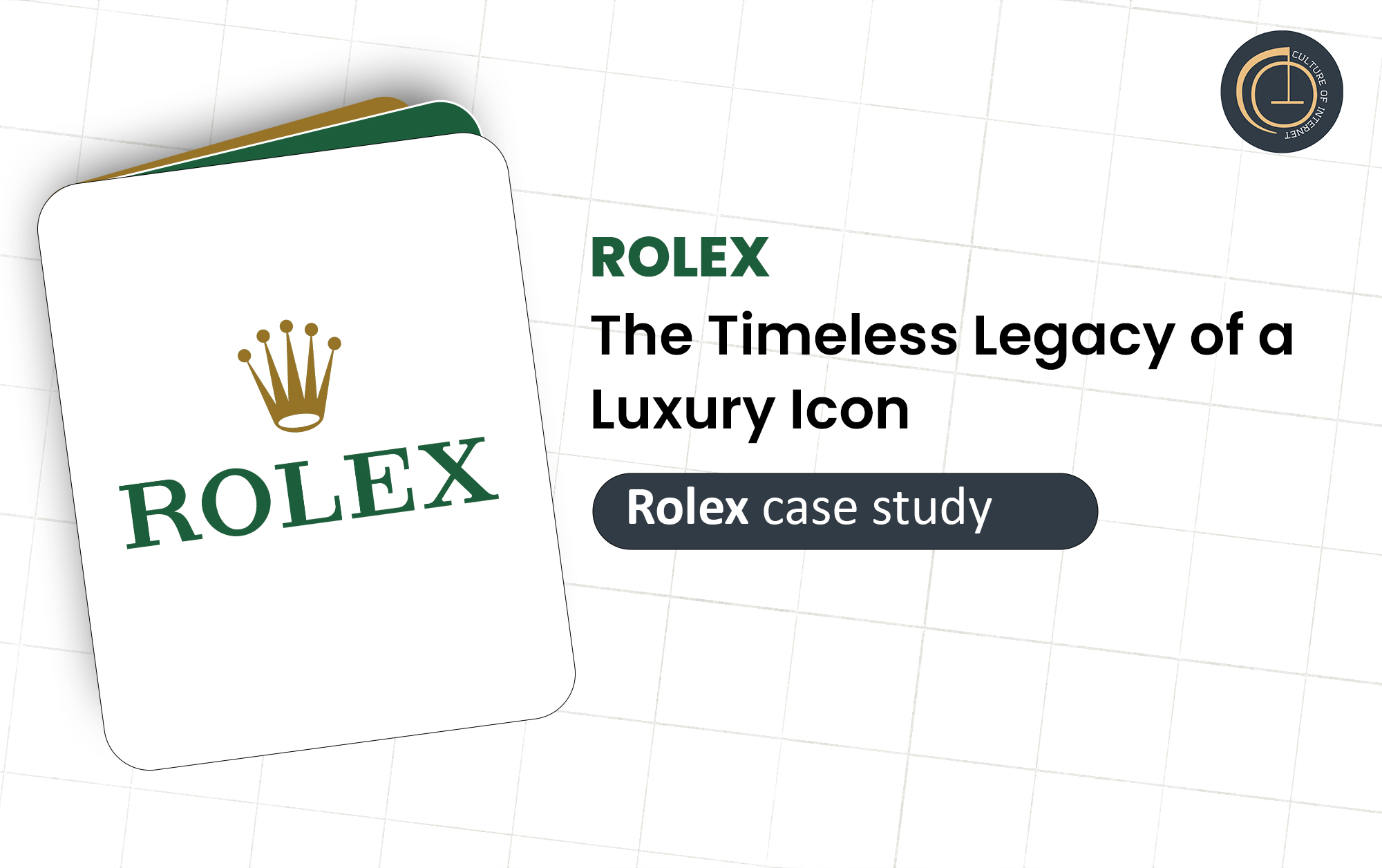Rolex: Company Overview
Introduction
-
This comprehensive article dives deep into the brand’s incredible journey—its founding, revolutionary innovations, strategies, collaborations, acquisitions, and what makes it so unique. We will explore how Rolex came to dominate the luxury watch segment, stayed relevant in a digital era, and maintained its aura despite fierce competition. Spanning over 10,000 words, this guide serves as a deep dive into one of the most iconic brands in history.
Origin of Rolex
-
Rolex was founded in 1905 by Hans Wilsdorf and Alfred Davis in London, England. Originally known as "Wilsdorf and Davis," the company initially focused on distributing timepieces rather than manufacturing them. The brand’s vision was simple but ambitious: to produce wristwatches that were not only elegant but also precise and reliable.
-
Hans Wilsdorf, a German national, had a passion for watchmaking and recognized the potential of wristwatches at a time when pocket watches dominated. He saw wristwatches not just as jewelry but as tools of precision and convenience. This forward-thinking approach laid the foundation for Rolex's future.
-
The name "Rolex" was registered in 1908. Wilsdorf wanted a name that was short, easy to pronounce in any language, and elegant enough to be engraved on a watch face. He believed the name Rolex met all those criteria. In 1919, the company moved its headquarters to Geneva, Switzerland, the heart of fine watchmaking, due to better access to high-quality Swiss craftsmanship.
History and Milestones
Rolex has consistently stayed ahead of the curve, achieving several firsts in the watch industry. Here's a timeline of some of the brand’s most significant milestones:
First wristwatch to receive a Swiss Certificate of Chronometric Precision from the Official Watch Rating Centre in Bienne. brand.
Launch of the Rolex Oyster—the world’s first waterproof wristwatch.
Introduction of the Perpetual rotor, the world’s first self-winding mechanism.
Debut of the Datejust, the first wristwatch with an automatically changing date.
The Submariner is introduced—the first watch waterproof to 100 meters, revolutionizing diving watches.
The Rolex Day-Date becomes the first watch to display both the date and the day of the week spelled out.
Rolex Deep Sea Special reaches the bottom of the Mariana Trench with Jacques Piccard.
ntroduction of Cerachrom bezel inserts—scratch proof and fade-resistant.
The Rolex Deepsea Challenge watch withstands 12,000 meters of underwater pressure.
Rolex’s Current Market Position
Today, Rolex is the leading name in the luxury watch industry. Despite being a privately held company, Rolex’s market metrics are well-documented by industry analysts.
-
Annual Revenue: Estimated over $9 billion (2023)
-
Production Volume: Approximately 1 million watches per year
-
Employees: Over 30,000 worldwide
-
Global Presence: Distributed in more than 100 countries
-
Ownership: Hans Wilsdorf Foundation
Rolex watches are known to hold or even increase in value over time, a rarity in the luxury goods industry. This has made Rolex not just a fashion statement but an investment.
Compared to brands like Omega, Patek Philippe, and Audemars Piguet, Rolex leads in terms of brand awareness, sales, and desirability.
Rolex’s Tech Stack & Innovations
Rolex isn’t often discussed in the context of a “tech stack” like software companies are, but its in-house innovations are significant. Its manufacturing and research units operate at the cutting edge of material science and mechanical engineering.
Materials Used
-
Oyster Steel: Corrosion-resistant stainless steel
-
Everose Gold: Rolex’s proprietary rose gold alloy
-
Rolesor: Combination of gold and steel
-
Cerachrom: High-tech ceramic bezel insert
Movement Mechanisms:
-
Perpetual Calibers: In-house automatic movements
-
Parachrom Hairspring: Anti-magnetic and shock-resistant
-
Chronergy Escapement: Enhanced energy efficiency
Testing and QA:
-
Each watch undergoes pressure, impact, and waterproof testing
-
COSC + Rolex in-house certification for Superlative Chronometers
Sustainability Tech:
-
Rolex has invested in solar-powered manufacturing
-
Eco-conscious recycling and waste-reduction in production
Unique Selling Propositions (USPs)
Rolex isn’t just selling a watch—it’s selling legacy, performance, and status. Its USPs are deeply embedded in its brand DNA.
-
Precision and Quality: COSC-certified chronometers
-
Timeless Design: Models like the Submariner and Daytona are virtually unchanged and still iconic
-
Exclusivity: Limited production creates high demand and resale value
-
Resale Value: Rolex watches appreciate over time
-
Innovation with Tradition: While Rolex innovates, it does so without losing its classic identity
These USPs make Rolex not only desirable but also a smart purchase for collectors and enthusiasts alike.
How Rolex Became a Global Giant
Several factors contributed to Rolex’s meteoric rise and continued dominance:
-
Innovation First: Pioneered waterproofing, self-winding mechanisms, and chronometric precision
-
Celebrity Endorsement: Worn by icons like Paul Newman, Martin Luther King Jr., and Roger Federer
-
India plant rolling out EQS, EQB—India’s first EV assembly line for luxury .
-
Sponsorships: Involved in high-status sports—yachting, tennis, golf, equestrianism
-
Philanthropy: Run by a foundation that funds scientific research and arts
-
Scarcity Marketing: Limited supply boosts demand
-
Brand Consistency: Rarely changes its branding, maintaining its elite status
Rolex understood early that perception is as important as product. Through clever marketing and consistent quality, it positioned itself as a symbol of achievement.
Digital Marketing Strategy
Despite being a traditional brand, Rolex has effectively used digital marketing to maintain relevance among younger audiences.
Website:
-
Minimalist, elegant, rich in storytelling
Social Media:
-
Instagram: Over 15 million followers
-
YouTube: Cinematic brand films and craftsmanship showcases
-
Facebook: Event sponsorships and updates
SEO and SEM:
-
Dominates search engine results for luxury watch-related keywords
-
Minimal use of paid ads; relies on organic traffic
Influencer Collaborations:
-
Works with elite brand ambassadors rather than social media influencers
Content Marketing:
-
Behind-the-scenes watchmaking stories
-
Explorer and athlete testimonials
Collaborations & Brand Ambassadors
Rolex has always chosen collaborations with purpose, usually centered around excellence, performance, and prestige.
Sports Partnerships:
-
Wimbledon Tennis Championships
-
Formula 1 Racing
-
PGA Tour (Golf)
-
Rolex 24 at Daytona (Motorsports)
Ambassadors:
-
Roger Federer: Tennis
-
Tiger Woods: Golf
-
James Cameron: Filmmaker and Deep Sea Explorer
-
Placido Domingo: Opera Singer
These associations strengthen Rolex’s alignment with values of endurance, precision, and peak performance.
Acquisitions & Business Moves
Rolex is extremely conservative in acquisitions. Its key business strategies include:
-
Vertical Integration: Owns its foundries, movement manufacturing units, and R&D centers
-
Limited Acquisitions: Acquired Bucherer in 2023, a luxury watch retail network
-
Focus on Control: Avoids partnerships that dilute brand
The Bucherer acquisition gives Rolex tighter control over distribution and brand experience, ensuring consistency and exclusivite
Q&A Section
-
Q1: Why are Rolex watches so expensive?
A: High-quality materials, precision engineering, in-house manufacturing, and brand prestige. -
Q2: Is a Rolex a good investment?
A: Yes. Some models appreciate significantly over time. -
Q3: How long does a Rolex last?
A: With proper care, a Rolex can last a lifetime—many are passed down through generations. -
Q4: Where are Rolex watches made?
A: Exclusively in Switzerland. -
Q5: How can I know if a Rolex is real?
A: Check the serial number, movement, weight, and purchase only from authorized dealers.
Conclusion
Rolex is far more than a watch manufacturer. It is a cultural icon, a technological innovator, and a symbol of timeless luxury. With over a century of heritage and a future rooted in innovation, Rolex is poised to continue leading the luxury watch industry. Its mix of tradition, craftsmanship, and strategic branding ensures it will remain relevant for generations to come.
Whether you’re a watch enthusiast, investor, or simply someone who appreciates luxury, Rolex represents the pinnacle of human achievement in timekeeping. A Rolex isn’t just worn—it’s lived.
Explore Our Comprehensive Marketing Strategy Course
Join our in-depth course to master Rolex India's marketing strategies, learn from expert case studies, and gain actionable insights to apply in your own business or career.









